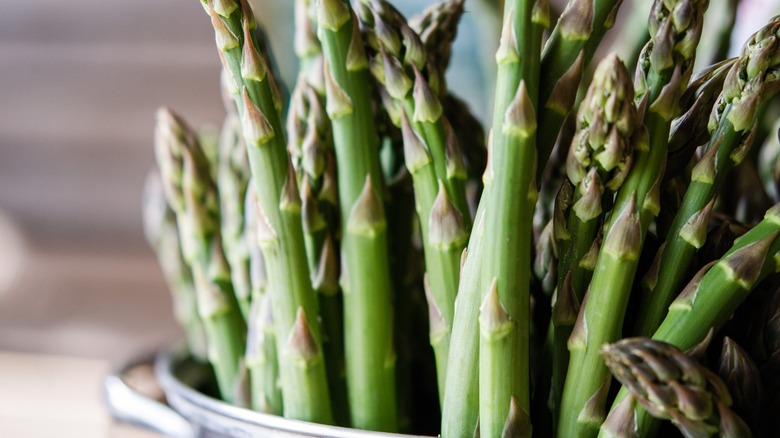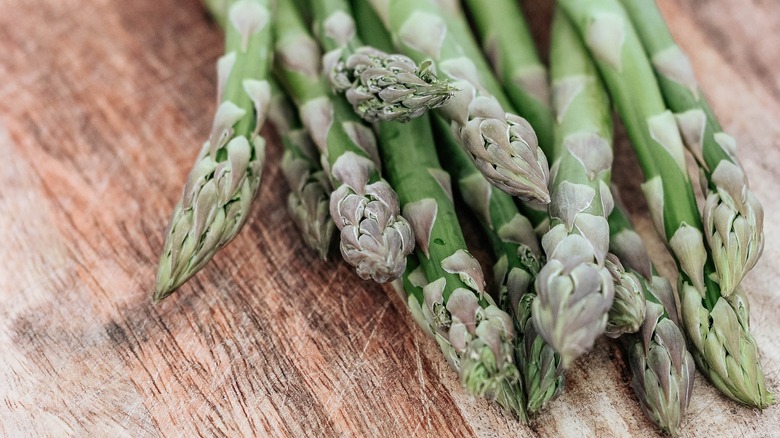Warning Signs Your Asparagus Has Gone Bad
Asparagus is a nutritious and delicious spring vegetable that complements a wide variety of dishes from freshly baked quiche to seafood and salmon. It is often found on brunch menus and is a centerpiece on holiday buffet tables. Dating back thousands of years and native to the Mediterranean (via Cultures de Chez Nous), the asparagus plant appears in haute cuisine and home kitchens alike. It has a heady and unique flavor similar to green onion and chives, two of its relatives. According to Wildflowers and Weeds, asparagus is part of the lily family. Its bright green or white stalks are a springtime delicacy that can now be had all year long.
The most succulent asparagus has tight flowered tips and tiny stalks, indicating young plants, whereas older plants produce thicker, intensely flavored stalks. The flowered tips are packed with the most flavor and nutrition but the entire stalk is edible. It can be blanched, steamed, baked, roasted, air-fried, pickled, and battered for tempura. No matter how you like your asparagus, it is a fantastic addition to your culinary repertoire.
This is why it is so important that you ensure your asparagus doesn't spoil before you get the chance to cook it. In order to prevent this, you need to spot the warning signs.
What bad asparagus looks and smells like
There are a few telltale signs that the asparagus you recently purchased is getting spoiled. Asparagus wilts and spoils quickly even under the best storage conditions so if you don't intend to eat it right away, keep an eye on it for signs of spoilage.
It is easy to spot wilted and old asparagus because the stalks are shriveled and not firmly upright. Fresh asparagus has a snap when you break it, and breaking spoiled asparagus will not result in the same sound. The stalks will appear limp and dull in color. If the asparagus is green, it will lose its waxy spring-green look. A similar occurrence happens with white asparagus, which will fade to grey or beige when rotting.
However, that is not all. The cut ends of the stalks will be dried out and fibrous. Wilted asparagus tips will become soft, and the flower tips will become black and will have an off, slightly sulfurous smell (via The U.S. Kitchen).
According to the Farm House Guide, you should also be on the lookout for mold and dark spots on the stalks. If your asparagus is wilted or even turned, it is best to toss it out.
Extending the life of your asparagus
Keeping asparagus fresh can be a challenge because the vegetable is delicate. When you buy fresh asparagus in tightly banded bunches, notice it is always standing upright in a bed of ice or cold water. Take it home and store it the same way in your refrigerator door with fresh water.
The Food Network advises wrapping the asparagus bunches in wet paper towels and covering them with a plastic bag or plastic wrap. Don't wash it until you are ready to use it. It is best when consumed within a day or two of purchasing it. Asparagus doesn't retain its flavors and aromas for long and keeping it upright will extend its vibrancy for a day or two.
Because asparagus is a seasonal vegetable, the Food Network suggests that you may want to freeze it to enjoy it later in the year. It is easy to freeze asparagus if you blanch it first. Make sure you clean it first by washing it under cool water. You may want to pre-cut the stalks into bite-sized pieces before freezing. Pop it into boiling water for a minute or two and then quickly cool in an icy water bath. Dry the asparagus before lightly packing it in plastic freezer bags, then store it by laying it flat in your freezer for up to eight months.
With these tips and tricks in mind, you'll be able to keep your asparagus fresh at the perfect time!


